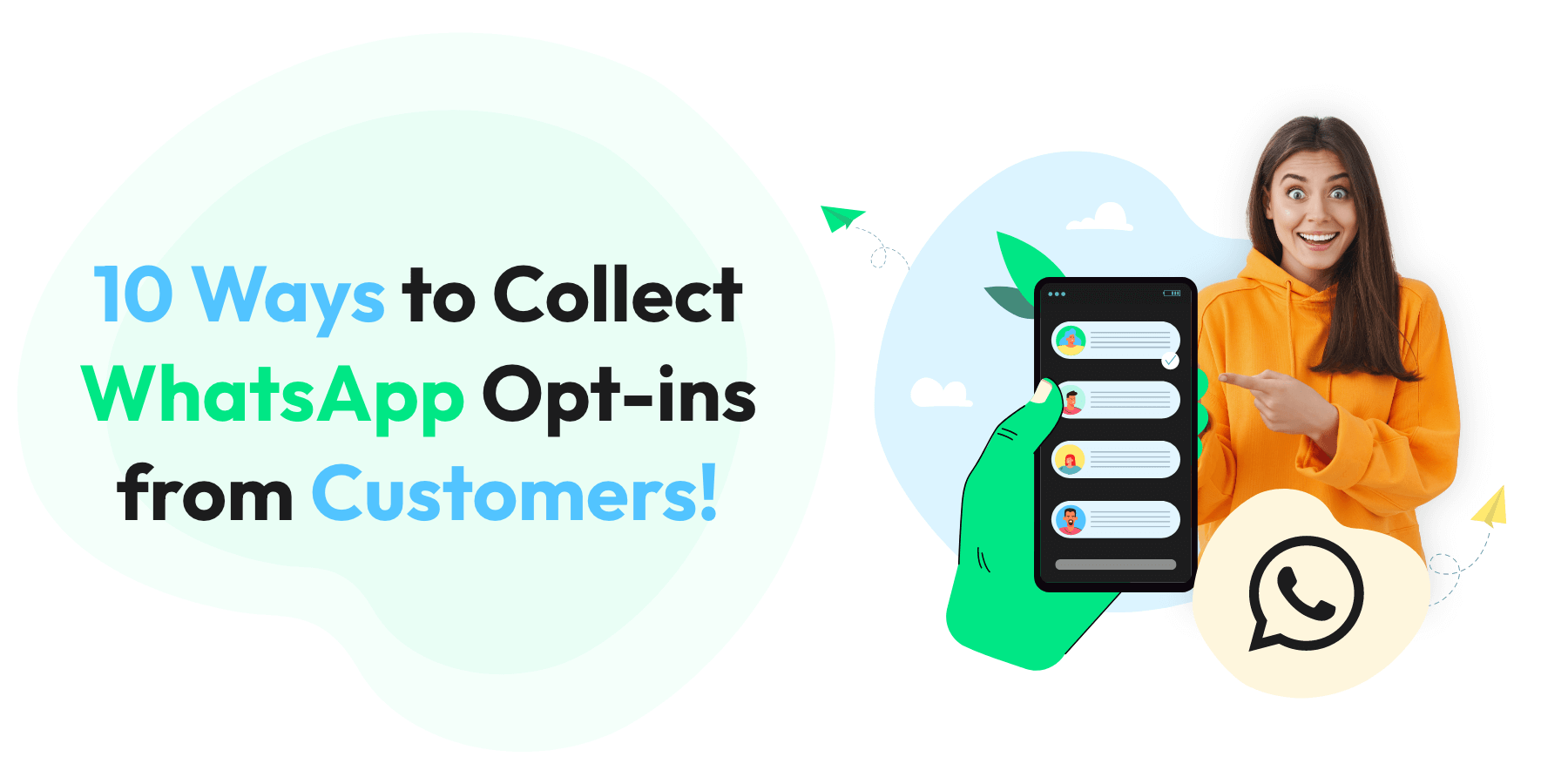
10 Ways to Collect WhatsApp Opt-ins from Customers in 2025!
Written by:
 Ashwin
|
on:
November 8, 2023
|
Last updated on:
December 30, 2024
|
According to: Editorial Policies
Ashwin
|
on:
November 8, 2023
|
Last updated on:
December 30, 2024
|
According to: Editorial Policies
You know how important it is to stay connected with your customers, right? And these days, everyone is using WhatsApp, probably you too! But here’s the catch: you can’t just start sending messages to your customers through WhatsApp – you need their WhatsApp opt-in first.
That’s where “opting in” comes into play. It’s like your customers saying, “Yes, please, I want to hear from you on WhatsApp!” But how do you get that crucial thumbs-up? Don’t worry!
This blog will show you the simple steps to get your customers on board, keeping everything friendly and official. So, let’s make sure your business messages aren’t just seen but welcomed!
What is WhatsApp Opt-In?
Okay, let’s break it down. Imagine you’re at your store, and there’s this customer you want to chat with on WhatsApp. You should tell them about a fantastic new product or a special deal. But before you hit “send” on that message, there’s one important rule: they must permit you first. That’s what a WhatsApp opt-in is!
It’s like when someone says, “Sure, you can send me texts about your business.” They’re giving you a green light because they’re interested in what you’ve got to say or offer.
This isn’t just a nice gesture; it’s a must-do because of privacy laws. So, you need to ask them clearly (usually with a quick message or a click of a button) if they’re okay with you sending them messages on WhatsApp. Once they say yes, that’s your cue!
They’ve “opted in,” and you’re all set to keep them in the loop directly through their favourite chat app.
Honestly, this is great for your business because people pay more attention to their WhatsApp messages, which means they’re more likely to notice all the awesome stuff you’re sharing!
Who Needs to Collect These WhatsApp Opt-Ins?
Here’s the straightforward answer: If you’re a business owner and you want to use WhatsApp to chat with your customers, you’ve got to collect opt-ins. It doesn’t matter if you run a cosy little cafe, a bustling online store, or a big tech company; this rule is for everyone.

Why Collect WhatsApp Opt-Ins?
Why? Because people value their privacy and don’t want just anyone sending them messages. Plus, there are laws to make sure businesses respect that. So, if you’re thinking about sending out updates, offers, or any news about your business on WhatsApp, you must ensure your customers are okay with it. It’s like asking if you can step into their digital home.
By getting their permission, you’re not only following the rules but also showing your customers you respect their choices, which is super important for building trust. And hey, when customers trust you, they’re more likely to listen to what you’ve got to say and engage with your business! So, collecting opt-ins is a win-win for you and your customers.
Ways to Collect WhatsApp Opt-Ins:
Collecting WhatsApp opt-ins can be smooth if you know the right ways to go about it. Here are some practical examples that you, as a business owner, can use to get those valuable permissions on your business platform:
1. Signup Forms on Your Website:
One of the easiest methods is to integrate a simple form on your website where customers can willingly enter their phone numbers. Place this form on your homepage, contact page, or as a pop-up that appears during their browsing session. Just make sure to specify that by entering their number, they agree to receive your WhatsApp messages.
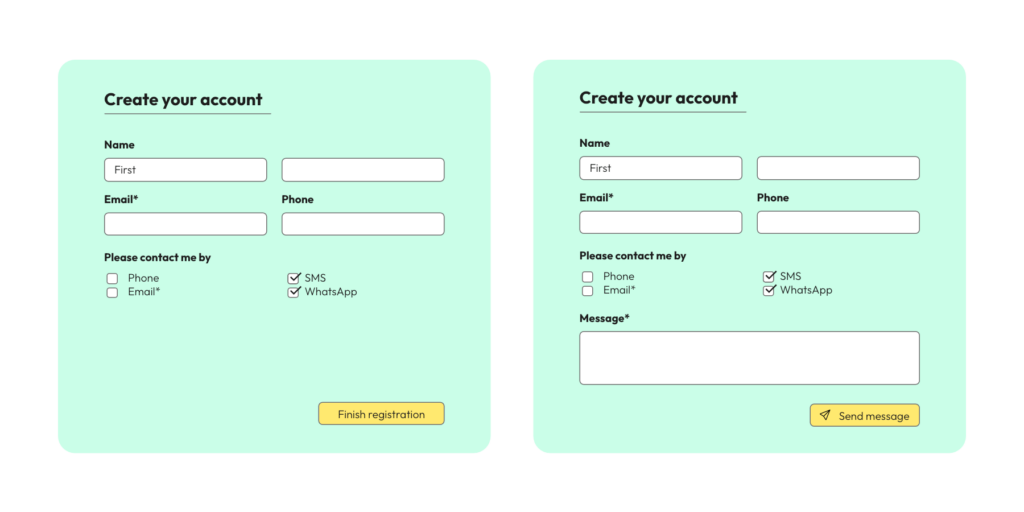
Also Check our free WhatsApp chat button generator for websites.
2. During Online Purchases:
If you have an online store, consider adding an opt-in checkbox during the checkout process. Customers can tick the box to agree to receive updates on their purchases and other notifications via WhatsApp.
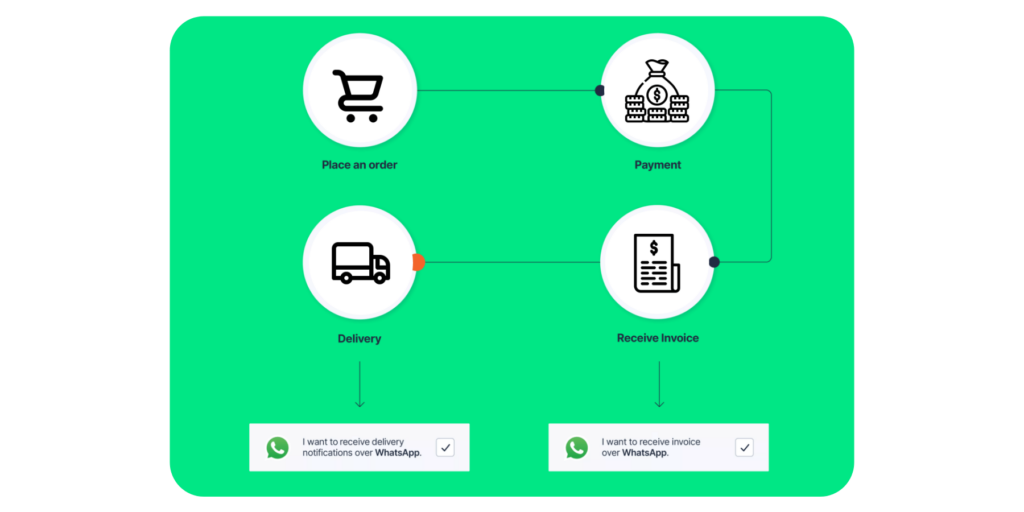
3. Interactive QR Codes in Physical Locations:
If you have a physical store, placing QR codes on receipts, product tags, or banners can be a smart move. When customers scan the QR code with their phones, they’re directed to a screen where they can opt-in to receive your WhatsApp messages.
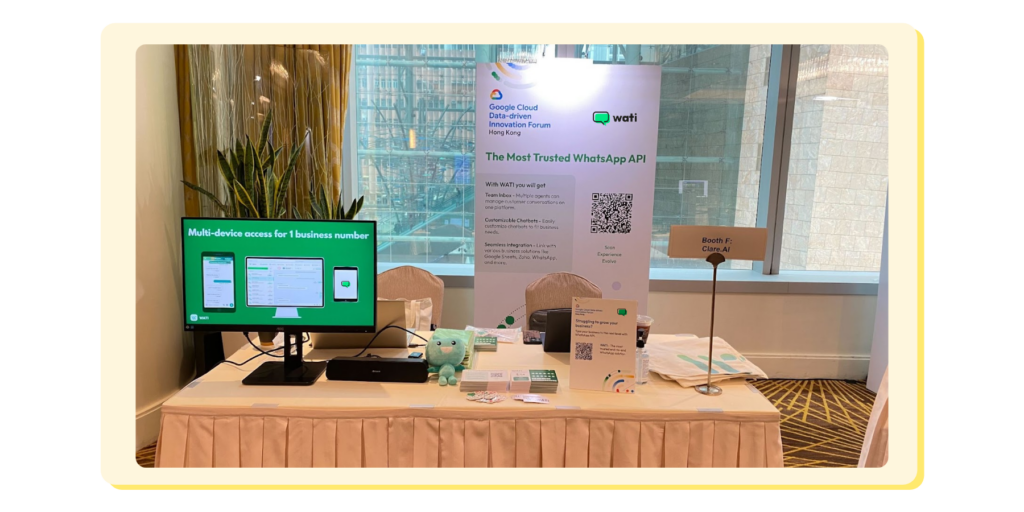
4. Social Media Channels:
Leverage your business’s social media profiles by creating posts or stories inviting followers to join your WhatsApp list. You can include a clickable link that takes them directly to a WhatsApp chat or a signup form.
5. Email Newsletters:
If you’re already sending out newsletters, include a section inviting subscribers to get exclusive content or special offers on WhatsApp. A simple “Join Us” button linked to your opt-in form or WhatsApp chat can do the trick.
6. Customer Support:
When customers contact you for support via email, chat, or even a phone call, your support team can ask if they’d like to receive WhatsApp messages for quicker, more convenient communication in the future.
7. Using pop-ups or QR codes on Your Main Webpage
Think about your website’s front page as a powerful way to get people interested. You can catch their eye immediately with a pop-up that shows up as they browse, suggesting they sign up to chat with you on WhatsApp.
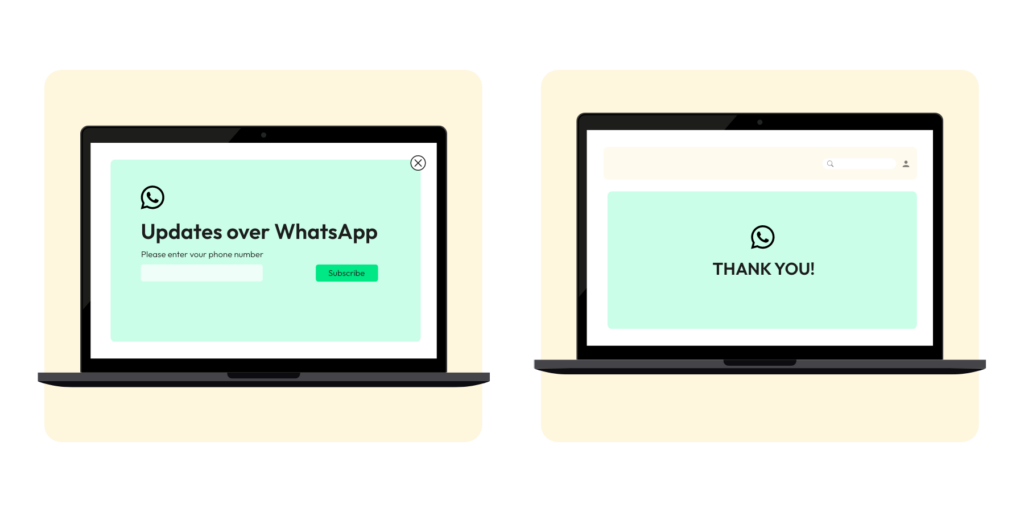
Another cool idea is to put a QR code directly on your front page. When customers scan it with their phones, they’ll be taken straight into a chat with your business on WhatsApp. It’s direct and super easy for them, making it more likely they’ll want to connect!
8. Landing Page for WhatsApp Opt-Ins:
Here’s a thought – why not set up a unique landing page just for getting people to chat with you on WhatsApp? This way, you can take more space to explain how chatting on WhatsApp makes interacting with your business easy and efficient.
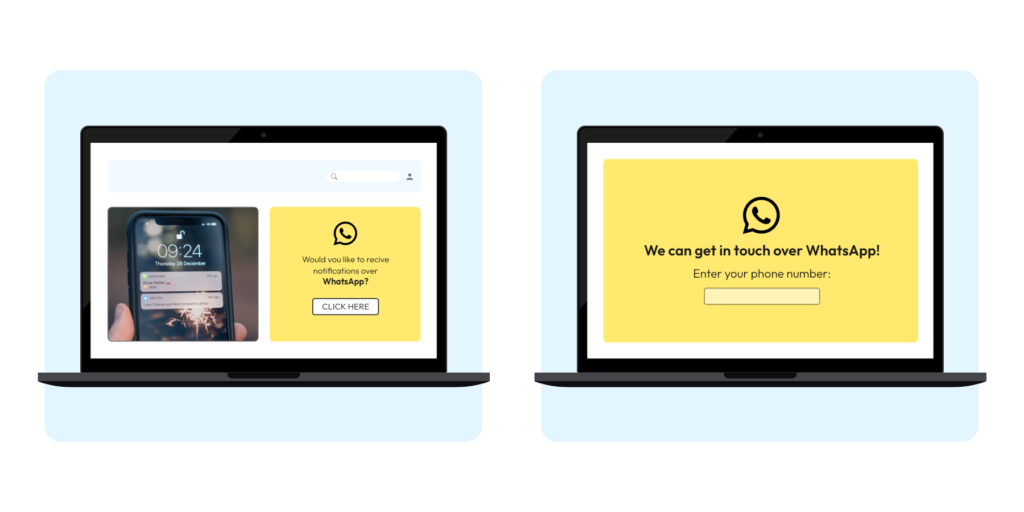
What your customers will do is type in their phone number on this page to say, “Yes, I’m in!” After they do, it’s a nice touch to send them over to another page that says “Thank You” to let them know everything worked perfectly.
A little advice: Double-check that this sign-up page looks good and works well no matter what gadget your customers use, be it a phone, tablet, or computer. That way, you won’t miss out on anyone who wants to join!
9. Setup Click to WhatsApp Ads
So, you’re already using social media to show off your products or get the word out with marketing. Why not use this chance to get customers chatting with you on WhatsApp?
You can add a special ‘click-to-chat’ button on your ads. This way, customers can just tap and start talking with you. The remarkable thing is the moment they click, you’ve got the green light to chat with them on WhatsApp. Plus, you’ll know what ad brought them to you and what interests them.
This means you can make your chat super relevant and personal for them based on what you know they like. It’s a neat way to make their experience feel smooth and tailored just for them!
10. Collect WhatsApp Opt-Ins from Various Channels
When texting a customer, why not ask if they’d prefer to get your messages on WhatsApp instead? It’s a quick question that could make things easier for both of you.

Also, if you’re using a phone system with automated responses (IVR), you can set it up to ask customers if they want to get your WhatsApp messages when they call you. It’s like they’re pressing ‘yes’ with their phone keypad!
And remember the old-school way! When you’re face-to-face with customers or when they’re filling out forms, you can ask them to sign up for your WhatsApp messages right there. They need to sign a form saying they’re cool with it, and you’re all set. It’s a bit more traditional, but it works like a charm!
Best Practices for Collecting WhatsApp Opt-Ins:
Getting those WhatsApp opt-ins sounds important, right? But you’re probably wondering, “How do I do it right?” No worries, here are some best practices that are easy to follow and can make a difference:
Be Clear and Honest: Tell your customers exactly what they sign up for. Will they get news about promotions, updates on their orders, or tips related to your business? Make sure they know so there are no surprises.
Easy Does It: Make the opt-in process super simple. Maybe it’s a button on your website that says, “Yes, I want to receive WhatsApp messages,” or a quick form at your store where they can share their number. The easier it is, the more likely they’ll say yes.
Respect the No’s: If someone doesn’t want to opt in, that’s okay. Never send WhatsApp messages if they disagree because that’s not cool (and also against the rules).
Offer Some Perks: People love goodies! Offer a special discount or a sneak peek of a new product if they sign up. It’s an excellent way to say “thank you” for letting you into their WhatsApp inbox.
Keep it Safe: Show your customers that you value their privacy. Ensure their data is safe and you follow all the privacy laws. This builds trust, and they’ll appreciate it.
Allow Easy Opt-out: Sometimes, people change their minds, and that’s alright. Make sure they can easily stop receiving messages if they want to. It could be a simple message they send you, like, “Stop,” and you’ll do the rest.
Remember, it’s about building a friendly relationship with your customers. When they see you’re doing things the right way, they’ll feel more comfortable and happy to hear from your business on WhatsApp!
Types of Messages Customers Can WhatsApp Opt-In to Receive:
Messages about their purchases or services:
- Delivery Updates
- Appointments Reminders
- Order Confirmation
- Bank Account Balance
Messages that aren’t directly about a purchase:
- Product Suggestions
- Helpful alerts
- Offers & Discounts
Your To-Do List for Getting WhatsApp Opt-Ins
We’ve got a simple 3-step checklist for you, all based on the l rules from WhatsApp about getting people to opt-in.
1. Choose a Way to Get More WhatsApp Opt-Ins
Good news! You’ve got many ways to ask customers to opt in, and you can do this on or off WhatsApp. Meta, which owns WhatsApp, has made this process simpler by taking away some old rules.
You don’t need to worry about these old rules anymore:
- Having to get opt-ins through other 3rd party channels
- Getting people to agree during specific steps only
- Having to show a checkbox next to the WhatsApp logo
- Letting users change the WhatsApp number they’re using to sign up
2. Play by the Rules with Your WhatsApp Opt-in method
When you ask someone to agree to get your messages, you’ve got to be super clear they’re saying yes to hearing from you on WhatsApp. Also, don’t forget to follow all the legal stuff. This includes:
- Getting all the correct permissions to use their details and having a privacy policy everyone can see.
- Keeping their stuff private and not using it outside of your chats.
- Not asking for things you shouldn’t, like their bank info, ID numbers, or health stuff.
Heads up: WhatsApp suggests working with their business service providers (they call them BSPs) like Wati, who know a lot about using WhatsApp for business. They can also help make sure you’re following all the local rules, especially those really strict privacy ones like GDPR.
3. Set Expectations to Avoid Opt-Outs
- Have a WhatsApp Business profile that tells customers how to get in touch (like your email, website, or phone number). And keep that info right!
- When collecting opt-ins, be clear about what kind of messages you’ll be sending. Different types of updates should have their opt-ins.
- Tell people how they can stop getting your messages and respect their word if they say no more, even if they tell you elsewhere. Take them off your contact list right away.
- If people can say “no thanks” quickly, they’re not going to report you or block you (which would make WhatsApp think you’re not doing a great job).
- Don’t message people too much. Think about how often they’d want to hear from you.
- Explain why it’s good for them to get your important updates on WhatsApp.
Remember, it’s all about making sure your customers are happy and know what they’re opting in for!

How does WhatsApp Make Sure You’re Following the Opt-In Rules?
If your customers feel they’re getting messages they didn’t sign up for, they might block you or even report your business. WhatsApp pays attention to this stuff. They’ll take a look at how you’re asking people to sign up and make sure you’re not breaking any rules.
If lots of people keep blocking or reporting you, WhatsApp will notice. They keep track of something called a “quality score.” If your score gets too low because you’re getting lots of negative reactions, WhatsApp might put some limits on your account. They could even stop you from using WhatsApp for business at all.
And WhatsApp doesn’t just do this once; they keep checking. They look at customer feedback and keep an eye on businesses to make sure everyone is following the rules. If they see something they don’t like, they’ll take action, and they’re always coming up with new ways to enforce their policies. So, it’s super important to ensure people are happy and have agreed to receive your messages!
Wrapping it Up
And there you have it! You’re now all set with ten practical strategies to get your customers to say “Yes” to receiving your messages on WhatsApp. Remember, make the opt-in process as straightforward as possible and respect your customers’ choices and privacy. Whether through eye-catching pop-ups on your website, easy-to-scan QR codes, or direct personal requests, every method should be about convenience and building trust.
Remember, the more comfortable and informed your customers feel, the more likely they are to opt-in. And once they do, you’ve got a direct line to build those relationships, boost engagement, and even drive sales. So, take these tips, get creative, and start growing your business’s presence where your customers spend their time – on WhatsApp!
Frequently Asked Questions
What is a WhatsApp Opt-In?
A WhatsApp Opt-In is an explicit permission granted by a customer to a business, allowing the business to send them messages via WhatsApp. This is in compliance with WhatsApp’s policies that require businesses to obtain consent before sending proactive messages to customers.
Why is getting a WhatsApp Opt-In important?
Obtaining a WhatsApp Opt-In is crucial because it ensures that your business is following WhatsApp’s guidelines and regulations, which require consent before communication. It also helps in building a database of interested and engaged customers, which can lead to higher conversion rates.
Are there any legal considerations with WhatsApp Opt-Ins?
Yes, depending on your location and the location of your customers, there are different legal considerations such as GDPR in Europe, which requires clear and affirmative consent for data to be used for communication.
What are some ways to collect WhatsApp Opt-Ins from customers?
Some ways to collect opt-ins include through a website opt-in form, during the checkout process, via QR codes, through SMS or email campaigns, social media channels, customer service interactions, in-store signage, events, and contests or sweepstakes.
Can I purchase a list of contacts and send them WhatsApp messages?
No, purchasing a list of contacts is against WhatsApp’s policies. You must collect opt-ins directly from customers who have shown interest in receiving messages from your business.
How can I ensure customers know they are opting in to WhatsApp messages?
You can ensure this by making the opt-in process clear and transparent. Inform customers what types of messages they will receive and how often. Include a clear call to action and an easy way for them to opt out at any time.
Is a customer’s interaction with my business considered as an Opt-In?
Not necessarily. A customer’s interaction is only considered an opt-in if they have been clearly informed that such interactions will lead to WhatsApp communication and they agree to it.
Can I send promotional messages to customers who have opted in?
Yes, as long as the customers have opted in to receive such messages. You should also respect the frequency preferences they have indicated if any.
How can I track the performance of my WhatsApp Opt-In strategy?
You can track performance by monitoring metrics such as opt-in rates, the number of messages sent, message open rates, response rates, and conversion rates from the messages.
What should I do if a customer wants to opt out of WhatsApp messages?
You should immediately honor the opt-out request by removing the customer from your WhatsApp messaging list. Provide an easy and straightforward way for them to opt out, like a simple command or link they can use without hassle.




Latest Comments